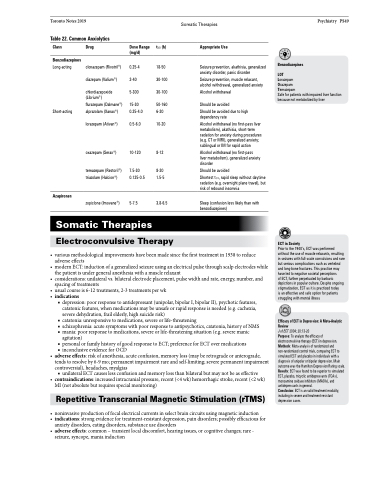Page 1213 - TNFlipTest
P. 1213
Toronto Notes 2019
Somatic Therapies
Psychiatry PS49
Table 22. Common Anxiolytics
Class
Benzodiazepines
Long-acting
Short-acting
Drug
clonazepam (Rivotril®) diazepam (Valium®)
chlordiazepoxide (Librium®)
flurazepam (Dalmane®) alprazolam (Xanax®)
lorazepam (Ativan®)
oxazepam (Serax®)
temazepam (Restoril®) triazolam (Halcion®)
zopiclone (Imovane®)
Dose Range (mg/d)
0.25-4
2-40
5-300
15-30 0.25-4.0
0.5-6.0
10-120
7.5-30 0.125-0.5
5-7.5
t1/2 (h)
18-50
30-100
30-100
50-160 6-20
10-20
8-12
8-20 1.5-5
3.8-6.5
Appropriate Use
Seizure prevention, akathisia, generalized anxiety disorder, panic disorder
Seizure prevention, muscle relaxant, alcohol withdrawal, generalized anxiety
Alcohol withdrawal
Should be avoided
Should be avoided due to high dependency rate
Alcohol withdrawal (no first-pass liver metabolism), akathisia, short-term sedation for anxiety during procedures (e.g. CT or MRI), generalized anxiety; sublingual or IM for rapid action
Alcohol withdrawal (no first-pass liver metabolism), generalized anxiety disorder
Should be avoided
Shortest t1/2, rapid sleep without daytime sedation (e.g. overnight plane travel), but risk of rebound insomnia
Sleep (confusion less likely than with benzodiazepines)
Benzodiazepines LOT
Lorazepam
Oxazepam
Temazepam
Safe for patients with impaired liver function because not metabolized by liver
Azapirones
Somatic Therapies
Electroconvulsive Therapy
ECT in Society
Prior to the 1940’s, ECT was performed without the use of muscle relaxants, resulting in seizures with full-scale convulsions and rare but serious complications such as vertebral and long-bone fractures. This practice may have led to negative societal perceptions
of ECT, further perpetuated by barbaric depictions in popular culture. Despite ongoing stigmatization, ECT as it is practiced today
is an effective and safe option for patients struggling with mental illness
Efficacy of ECT in Depression: A Meta-Analytic Review
J of ECT 2004; 20:13-20
Purpose: To analyze the efficacy of electroconvulsive therapy (ECT) in depression. Methods: Meta-analysis of randomized and non-randomized control trials, comparing ECT to simulated ECT and placebo in individuals with a diagnosis of unipolar or bipolar depression. Main outcome was the Hamilton Depression Rating scale. Results: ECT was found to be superior to simulated ECT, placebo, tricyclic antidepressants (TCAs), monoamine oxidase inhibitors (MAOIs), and antidepressants in general.
Conclusion: ECT is an valid treatment modality, including in severe and treatment-resistant depression cases.
• variousmethodologicalimprovementshavebeenmadesincethefirsttreatmentin1938toreduce adverse effects
• modernECT:inductionofageneralizedseizureusinganelectricalpulsethroughscalpelectrodeswhile the patient is under general anesthesia with a muscle relaxant
• considerations: unilateral vs. bilateral electrode placement, pulse width and rate, energy, number, and spacing of treatments
• usualcourseis6-12treatments,2-3treatmentsperwk
• indications
■ depression: poor response to antidepressant (unipolar, bipolar I, bipolar II), psychotic features, catatonic features, when medications may be unsafe or rapid response is needed (e.g. cachexia, severe dehydration, frail elderly, high suicide risk)
■ catatonia: unresponsive to medications, severe or life-threatening
■ schizophrenia: acute symptoms with poor response to antipsychotics, catatonia, history of NMS
■ mania: poor response to medications, severe or life-threatening situation (e.g. severe manic
agitation)
■ personal or family history of good response to ECT; preference for ECT over medications ■ inconclusive evidence for OCD
• adverse effects: risk of anesthesia, acute confusion, memory loss (may be retrograde or anterograde, tends to resolve by 6-9 mo; permanent impairment rare and self-limiting; severe permanent impairment controversial), headaches, myalgias
■ unilateral ECT causes less confusion and memory loss than bilateral but may not be as effective
• contraindications:increasedintracranialpressure,recent(<4wk)hemorrhagicstroke,recent(<2wk)
MI (not absolute but requires special monitoring)
Repetitive Transcranial Magnetic Stimulation (rTMS)
• noninvasiveproductionoffocalelectricalcurrentsinselectbraincircuitsusingmagneticinduction
• indications:strongevidencefortreatment-resistantdepression,paindisorders;possiblyefficaciousfor
anxiety disorders, eating disorders, substance use disorders
• adverseeffects:common–transientlocaldiscomfort,hearingissues,orcognitivechanges;rare-
seizure, syncope, mania induction


